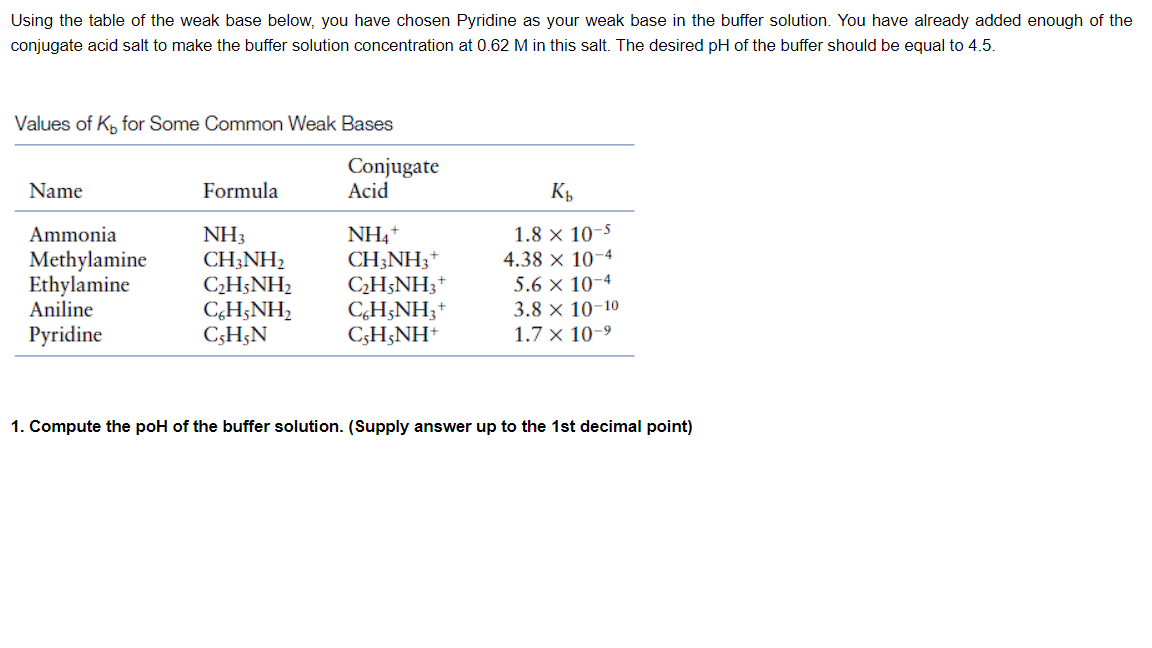Chemistry: The Molecular Science
5th Edition
ISBN:9781285199047
Author:John W. Moore, Conrad L. Stanitski
Publisher:John W. Moore, Conrad L. Stanitski
Chapter15: Additional Aqueous Equilibria
Section: Chapter Questions
Problem 108QRT
Related questions
Question
Using the table of the weak base below, you have chosen Pyridine as your weak base in the buffer solution. You have already added enough of the conjugate acid salt to make the buffer solution concentration at 0.62 M in this salt. The desired pH of the buffer should be equal to 4.5.
1. Compute the poH of the buffer solution. (Supply answer up to the 1st decimal point)

Transcribed Image Text:Using the table of the weak base below, you have chosen Pyridine as your weak base in the buffer solution. You have already added enough of the
conjugate acid salt to make the buffer solution concentration at 0.62 M in this salt. The desired pH of the buffer should be equal to 4.5.
Values of K for Some Common Weak Bases
Conjugate
Name
Formula
Acid
Kb
Ammonia
1.8 x 10-5
NH3
CH,NH,
Methylamine
NH4+
CH3NH3+
4.38 x 10-4
Ethylamine
C₂H5NH₂
C₂H5NH3 +
5.6 x 10-4
Aniline
CH;NH,
C6H5NH3 +
3.8 x 10-10
Pyridine
C,H,N
CH;NH*
1.7 x 10-9
1. Compute the poH of the buffer solution. (Supply answer up to the 1st decimal point)
Expert Solution
This question has been solved!
Explore an expertly crafted, step-by-step solution for a thorough understanding of key concepts.
Step by step
Solved in 2 steps with 2 images

Follow-up Questions
Read through expert solutions to related follow-up questions below.
Follow-up Question
2. Compute for pKb. (Supply answer up to the 2nd decimal point.)
Solution
Knowledge Booster
Learn more about
Need a deep-dive on the concept behind this application? Look no further. Learn more about this topic, chemistry and related others by exploring similar questions and additional content below.Recommended textbooks for you

Chemistry: The Molecular Science
Chemistry
ISBN:
9781285199047
Author:
John W. Moore, Conrad L. Stanitski
Publisher:
Cengage Learning

Chemistry: Principles and Practice
Chemistry
ISBN:
9780534420123
Author:
Daniel L. Reger, Scott R. Goode, David W. Ball, Edward Mercer
Publisher:
Cengage Learning


Chemistry: The Molecular Science
Chemistry
ISBN:
9781285199047
Author:
John W. Moore, Conrad L. Stanitski
Publisher:
Cengage Learning

Chemistry: Principles and Practice
Chemistry
ISBN:
9780534420123
Author:
Daniel L. Reger, Scott R. Goode, David W. Ball, Edward Mercer
Publisher:
Cengage Learning


Principles of Modern Chemistry
Chemistry
ISBN:
9781305079113
Author:
David W. Oxtoby, H. Pat Gillis, Laurie J. Butler
Publisher:
Cengage Learning

Chemistry & Chemical Reactivity
Chemistry
ISBN:
9781133949640
Author:
John C. Kotz, Paul M. Treichel, John Townsend, David Treichel
Publisher:
Cengage Learning

Chemistry & Chemical Reactivity
Chemistry
ISBN:
9781337399074
Author:
John C. Kotz, Paul M. Treichel, John Townsend, David Treichel
Publisher:
Cengage Learning